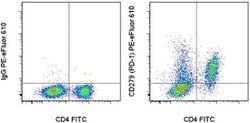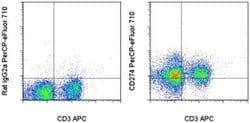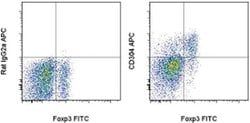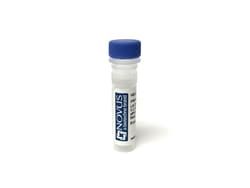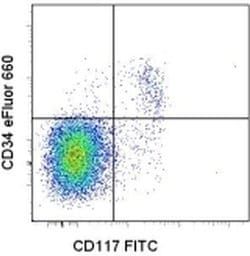7092299
CD279 (PD-1) Monoclonal Antibody (RMP1-30), eFluor™ 450, eBioscience™, Invitrogen™
Rat Monoclonal Antibody
Manufacturer: Fischer Scientific
The price for this product is unavailable. Please request a quote
Antigen
CD279 (PD-1)
Concentration
0.2 mg/mL
Classification
Monoclonal
Form
Liquid
Regulatory Status
RUO
Formulation
PBS with 0.09% sodium azide; pH 7.2
Gene Alias
CD279; EGK_05005; hPD1; hPD-1; hPD-l; hSLE1; Ly101; mPD-1; PD1; PD-1; Pdc1; Pdcd1; programmed cell death 1; programmed cell death 1 protein; programmed cell death protein 1; programmed cell death protein 1-like; programmed death 1; Protein PD1; protein PD-1; sCD279; SLEB2; soluble CD279; systemic lupus erythematosus susceptibility 2
Gene Symbols
Pdcd1
Primary or Secondary
Primary
Content And Storage
4° C, store in dark, DO NOT FREEZE!
Gene
Pdcd1
Clone
RMP1-30
Applications
Flow Cytometry
Conjugate
eFluor 450
Host Species
Rat
Target Species
Mouse
Gene Accession No.
Q02242
Gene ID (Entrez)
18566
Isotype
IgG2b κ
Purification Method
Affinity chromatography
Product Type
Antibody
Description
- Description: The RMP1-30 antibody reacts with mouse PD-1 (programmed death-1), a 55 kDa member of the Ig superfamily
- PD-1 contains the immunoreceptor tyrosine-based inhibitory motif (ITIM) and plays a key role in peripheral tolerance and autoimmune disease in mice
- PD-1 is expressed mainly on activated T and B lymphocytes
- Two novel B7 Family members have been identified as PD-1 ligands, PD-L1 (B7-H1) and PD-L2 (B7-DC)
- Evidence reported to date suggests overlapping functions for these ligands and their constitutive expression on some normal tissues and upregulation on activated antigen-presenting cells
- RMP1-30 does not block the binding of either B7-H1-Ig or B7-DC-Ig to PD-1 transfectants
- Applications Reported: This RMP1-30 antibody has been reported for use in flow cytometric analysis
- Applications Tested: This RMP1-30 antibody has been tested by flow cytometric analysis of activated mouse splenocytes
- This can be used at less than or equal to 1 μg per test
- A test is defined as the amount (μg) of antibody that will stain a cell sample in a final volume of 100 μL
- Cell number should be determined empirically but can range from 10^5 to 10^8 cells/test
- It is recommended that the antibody be carefully titrated for optimal performance in the assay of interest
- eFluor™ 450 is an alternative to Pacific Blue™
- eFluor™ 450 emits at 445 nm and is excited with the Violet laser (405 nm)
- Cell-mediated immune responses are initiated by T lymphocytes that are themselves stimulated by cognate peptides bound to MHC molecules on antig en-presenting cells (APC)
- T-cell activation is generally self-limited as activated T cells express receptors such as PD-1 (also known as PDCD-1) that mediate inhibitory signals from the APC
- PD-1 can bind two different but related ligands, PDL-1 and PDL-2
- Upon binding to either of these ligands, signals generated by PD-1 inhibit the activation of the immune response in the absence of "edanger signals"e such as LPS or other molecules associated with bacteria or other pathogens
- Evidence for this is seen in PD1-null mice who exhibit hyperactivated immune systems and autoimmune diseases
- Despite its predicted molecular weight, PD-1 often migrates at higher molecular weight in SDS-PAGE.
Compare Similar Items
Show Difference
Antigen: CD279 (PD-1)
Concentration: 0.2 mg/mL
Classification: Monoclonal
Form: Liquid
Regulatory Status: RUO
Formulation: PBS with 0.09% sodium azide; pH 7.2
Gene Alias: CD279; EGK_05005; hPD1; hPD-1; hPD-l; hSLE1; Ly101; mPD-1; PD1; PD-1; Pdc1; Pdcd1; programmed cell death 1; programmed cell death 1 protein; programmed cell death protein 1; programmed cell death protein 1-like; programmed death 1; Protein PD1; protein PD-1; sCD279; SLEB2; soluble CD279; systemic lupus erythematosus susceptibility 2
Gene Symbols: Pdcd1
Primary or Secondary: Primary
Content And Storage: 4° C, store in dark, DO NOT FREEZE!
Gene: Pdcd1
Clone: RMP1-30
Applications: Flow Cytometry
Conjugate: eFluor 450
Host Species: Rat
Target Species: Mouse
Gene Accession No.: Q02242
Gene ID (Entrez): 18566
Isotype: IgG2b κ
Purification Method: Affinity chromatography
Product Type: Antibody
Antigen:
CD279 (PD-1)
Concentration:
0.2 mg/mL
Classification:
Monoclonal
Form:
Liquid
Regulatory Status:
RUO
Formulation:
PBS with 0.09% sodium azide; pH 7.2
Gene Alias:
CD279; EGK_05005; hPD1; hPD-1; hPD-l; hSLE1; Ly101; mPD-1; PD1; PD-1; Pdc1; Pdcd1; programmed cell death 1; programmed cell death 1 protein; programmed cell death protein 1; programmed cell death protein 1-like; programmed death 1; Protein PD1; protein PD-1; sCD279; SLEB2; soluble CD279; systemic lupus erythematosus susceptibility 2
Gene Symbols:
Pdcd1
Primary or Secondary:
Primary
Content And Storage:
4° C, store in dark, DO NOT FREEZE!
Gene:
Pdcd1
Clone:
RMP1-30
Applications:
Flow Cytometry
Conjugate:
eFluor 450
Host Species:
Rat
Target Species:
Mouse
Gene Accession No.:
Q02242
Gene ID (Entrez):
18566
Isotype:
IgG2b κ
Purification Method:
Affinity chromatography
Product Type:
Antibody
Antigen: __
Concentration: __
Classification: __
Form: __
Regulatory Status: __
Formulation: __
Gene Alias: __
Gene Symbols: __
Primary or Secondary: __
Content And Storage: __
Gene: __
Clone: __
Applications: __
Conjugate: __
Host Species: __
Target Species: __
Gene Accession No.: __
Gene ID (Entrez): __
Isotype: __
Purification Method: __
Product Type: __
Antigen:
__
Concentration:
__
Classification:
__
Form:
__
Regulatory Status:
__
Formulation:
__
Gene Alias:
__
Gene Symbols:
__
Primary or Secondary:
__
Content And Storage:
__
Gene:
__
Clone:
__
Applications:
__
Conjugate:
__
Host Species:
__
Target Species:
__
Gene Accession No.:
__
Gene ID (Entrez):
__
Isotype:
__
Purification Method:
__
Product Type:
__
Antigen: CD279 (PD-1)
Concentration: 0.2 mg/mL
Classification: Monoclonal
Form: Liquid
Regulatory Status: RUO
Formulation: PBS with 0.09% sodium azide; pH 7.2
Gene Alias: CD279; EGK_05005; hPD1; hPD-1; hPD-l; hSLE1; Ly101; mPD-1; PD1; PD-1; Pdc1; Pdcd1; programmed cell death 1; programmed cell death 1 protein; programmed cell death protein 1; programmed cell death protein 1-like; programmed death 1; Protein PD1; protein PD-1; sCD279; SLEB2; soluble CD279; systemic lupus erythematosus susceptibility 2
Gene Symbols: Pdcd1
Primary or Secondary: Primary
Content And Storage: 4° C, store in dark, DO NOT FREEZE!
Gene: Pdcd1
Clone: J43
Applications: Flow Cytometry
Conjugate: eFluor 450
Host Species: Armenian Hamster
Target Species: Mouse
Gene Accession No.: Q02242
Gene ID (Entrez): 18566
Isotype: IgG
Purification Method: Affinity chromatography
Product Type: Antibody
Antigen:
CD279 (PD-1)
Concentration:
0.2 mg/mL
Classification:
Monoclonal
Form:
Liquid
Regulatory Status:
RUO
Formulation:
PBS with 0.09% sodium azide; pH 7.2
Gene Alias:
CD279; EGK_05005; hPD1; hPD-1; hPD-l; hSLE1; Ly101; mPD-1; PD1; PD-1; Pdc1; Pdcd1; programmed cell death 1; programmed cell death 1 protein; programmed cell death protein 1; programmed cell death protein 1-like; programmed death 1; Protein PD1; protein PD-1; sCD279; SLEB2; soluble CD279; systemic lupus erythematosus susceptibility 2
Gene Symbols:
Pdcd1
Primary or Secondary:
Primary
Content And Storage:
4° C, store in dark, DO NOT FREEZE!
Gene:
Pdcd1
Clone:
J43
Applications:
Flow Cytometry
Conjugate:
eFluor 450
Host Species:
Armenian Hamster
Target Species:
Mouse
Gene Accession No.:
Q02242
Gene ID (Entrez):
18566
Isotype:
IgG
Purification Method:
Affinity chromatography
Product Type:
Antibody
Antigen: CD34
Concentration: 0.2 mg/mL
Classification: Monoclonal
Form: Liquid
Regulatory Status: RUO
Formulation: PBS with 0.09% sodium azide; pH 7.2
Gene Alias: (E3-independent) E2 ubiquitin-conjugating enzyme R1; AU040960; CD34; CD34 antigen; CD34 molecule; CDC34; cell division cycle 34; cell division cycle 34 homolog; cluster designation 34; cluster of differentiation antigen 34; E2 ubiquitin-conjugating enzyme R1; E2-CDC34; hematopoietic progenitor cell antigen CD34; hematopoietic progenitor cell marker CD34; Mucosialin; RP11-328D5.2; sialomucin protein; type 1 transmembrane protein; UBC3; UBCH3; UBE2R1; ubiquitin carrier protein; ubiquitin conjugating enzyme E2 R1; ubiquitin-conjugating enzyme E2 R1; Ubiquitin-conjugating enzyme E2-32 kDa complementing; ubiquitin-conjugating enzyme E2-CDC34; Ubiquitin-protein ligase R1
Gene Symbols: Cd34
Primary or Secondary: Primary
Content And Storage: 4° C, store in dark, DO NOT FREEZE!
Gene: Cd34
Clone: RAM34
Applications: Flow Cytometry
Conjugate: eFluor 660
Host Species: Rat
Target Species: Mouse
Gene Accession No.: Q64314
Gene ID (Entrez): 12490
Isotype: IgG2a κ
Purification Method: Affinity chromatography
Product Type: Antibody
Antigen:
CD34
Concentration:
0.2 mg/mL
Classification:
Monoclonal
Form:
Liquid
Regulatory Status:
RUO
Formulation:
PBS with 0.09% sodium azide; pH 7.2
Gene Alias:
(E3-independent) E2 ubiquitin-conjugating enzyme R1; AU040960; CD34; CD34 antigen; CD34 molecule; CDC34; cell division cycle 34; cell division cycle 34 homolog; cluster designation 34; cluster of differentiation antigen 34; E2 ubiquitin-conjugating enzyme R1; E2-CDC34; hematopoietic progenitor cell antigen CD34; hematopoietic progenitor cell marker CD34; Mucosialin; RP11-328D5.2; sialomucin protein; type 1 transmembrane protein; UBC3; UBCH3; UBE2R1; ubiquitin carrier protein; ubiquitin conjugating enzyme E2 R1; ubiquitin-conjugating enzyme E2 R1; Ubiquitin-conjugating enzyme E2-32 kDa complementing; ubiquitin-conjugating enzyme E2-CDC34; Ubiquitin-protein ligase R1
Gene Symbols:
Cd34
Primary or Secondary:
Primary
Content And Storage:
4° C, store in dark, DO NOT FREEZE!
Gene:
Cd34
Clone:
RAM34
Applications:
Flow Cytometry
Conjugate:
eFluor 660
Host Species:
Rat
Target Species:
Mouse
Gene Accession No.:
Q64314
Gene ID (Entrez):
12490
Isotype:
IgG2a κ
Purification Method:
Affinity chromatography
Product Type:
Antibody

